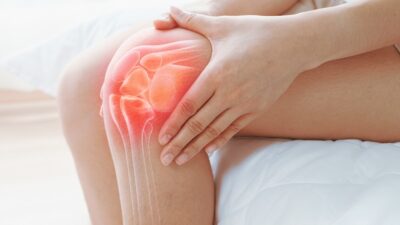High-Intensity Interval Training Improves Cognition
- The positive impact was observed even after 4.5 years of follow-up.

Cognitive decline is one of the risks associated with getting older, but new research suggests there may be a way to fight back. A new study suggests that high-intensity interval training improves spatial learning and maintains brain volume and connectivity [1].
Shrinking aging brain
One of the main cognitive functions that declines during dementia is spatial learning and memory. The part of the brain called the hippocampus is greatly responsible for those functions.
Previous research has identified a decrease in hippocampal volume and connectivity in an age-dependent manner [2-3]. Research in rodents identified physical activity as a promising approach to ameliorating hippocampal-dependent spatial learning [4-5].
The authors note there’s a “lack of studies examining the extent to which physical exercise affects hippocampal function in aged humans.” To fill this knowledge gap, they tested the effect of exercise on healthy elderly people.
More sweat, more gains
For their experiment, 151 participants, 65-85 years of age, were divided into three groups:
- Low-intensity training (LIT),
- Medium-intensity training (MIT)
- High-intensity interval training (HIIT)
All participants exercised three times a week for a 6 month period.
The study participants were given a hippocampal-dependent paired associated learning (PAL) test. This measures spatial learning, the ability to make a mental representation of the environment.
At the end of the study, the HIIT group performed better on the PAL test compared to the initial measurements. Improvements were also seen in the HIIT group in comparison to the MIT and LIT groups, which remained stable.
But the study didn’t stop there. Participants were tested 6 months after the exercise program ended, and then regularly for the next 4 years. These promising results for the HIIT group withstood the test of time. The HIIT group had better test scores over five years compared to the LIT and MIT groups. Meanwhile for the LIT and MIT groups test scores were not significantly different from the baseline.
The researchers observed that those who had the worst scores at the baseline seemed to benefit the most from the HIIT regimen. Those participants showed the greatest increase in test results, and they maintained it throughout the follow-up period.
The MIT group showed some improvement in low test scores, but the effects of the exercise were more modest. The authors note that, based on their results, “HIIT intervention was specific to the hippocampal-dependent spatial learning task.”
The researchers studied other parts of the brain as well. These parts did not show any difference in response to the intensity of the exercise. They also showed similar memory improvements in all groups. There were no improvements following the exercise in either visual working memory or emotional recognition.
Bigger and better-connected brain
The cognitive tests showed changes in brain volume, particularly in the right hippocampus. The right hippocampus is linked to spatial learning [6].
After 6 months of exercise, researchers found that the right hippocampal volume decreased significantly. This was true for both the LIT and MIT groups. However, the HIIT group maintained the hippocampal volume at 6 and 12 month time points.
The hippocampus was not the only brain region impacted by the exercise. The researchers observed differences between groups in brain regions responsible for motor functions, language processing, learning, and memory. HIIT exercise helped maintain the volume of those regions.
The HIIT group showed improvements to connections between brain networks for attention, movement, and vision during rest. This was in contrast to the LIT and MIT groups.
Biomarkers of cognitive improvement
Exercise has been previously described as impacting several blood biomarkers. The researchers measured whether these were associated with the hippocampal-dependent cognitive improvement they observed.
In the HIIT group, they observed a correlation between increased BDNF (a brain-derived neurotrophic factor that plays a role in neurogenesis and synaptic plasticity) and cortisol levels and improved hippocampal-dependent cognitive function.
They noted that cortisol can have different effects depending on the duration of the increased levels. While chronically elevated cortisol levels have detrimental effects on cognition [7], acute elevation, as during exercise, was reported to have beneficial effects [8].
The mechanism behind the BDNF, cortisol, and cognitive improvement caused by HIIT requires more research. The researchers believe BDNF and cortisol are biomarkers for the effectiveness of exercise on cognition in healthy elderly people. The researchers also identified a possible biomarker in the MIT group: prolactin. In this group, a decrease in prolactin levels correlated with improved hippocampal-dependent cognition.
The researchers hypothesized that the different reactions in biomarkers were likely due to the types of exercise. The MIT group did aerobic exercise, while the HIIT group did a mix of aerobic and anaerobic exercise. However, future studies will need to address this hypothesis in more depth.
The long-term effects
Overall researchers concluded that their “results highlight the specificity of HIIT in significantly improving hippocampal-dependent spatial learning in the healthy elderly.”
The authors point out that one of the most important findings here is the long-term effectiveness of an exercise regimen. As they discuss, older individuals have more difficulty performing high-intensity exercise. Therefore, it is essential to apply such interventions at younger ages. Their results suggest “that a relatively acute, 6-month HIIT intervention can maintain the improvement in hippocampal function for at least 4.5 years with no diminution of performance.”
The researchers discuss a few limitations of the study, for example, the lack of a non-exercise control group and the lack of addressing the varied types of exercise between groups. Also, the inclusion criteria limited the study group to elderly individuals with no cognitive deficits capable of following the 6-month exercise regimen, limiting the generalizability of results to less healthy or cognitively impaired elderly individuals.
That said, exercise, in particular HIIT, could be a good strategy to protect against cognitive decline.
Literature
[1] Blackmore, D. G., Schaumberg, M. A., Ziaei, M., Belford, S., To, X. V., O’Keeffe, I., Bernard, A., Mitchell, J., Hume, E., Rose, G. L., Shaw, T., York, A., Barth, M., Cooper, E. J., Skinner, T. L., Nasrallah, F., Riek, S., & Bartlett, P. F. (2024). Long-Term Improvement in Hippocampal-Dependent Learning Ability in Healthy, Aged Individuals Following High Intensity Interval Training. Aging and disease, 10.14336/AD.2024.0642. Advance online publication. https://doi.org/10.14336/AD.2024.0642
[2] Nobis, L., Manohar, S. G., Smith, S. M., Alfaro-Almagro, F., Jenkinson, M., Mackay, C. E., & Husain, M. (2019). Hippocampal volume across age: Nomograms derived from over 19,700 people in UK Biobank. NeuroImage. Clinical, 23, 101904. https://doi.org/10.1016/j.nicl.2019.101904
[3] Zonneveld, H. I., Pruim, R. H., Bos, D., Vrooman, H. A., Muetzel, R. L., Hofman, A., Rombouts, S. A., van der Lugt, A., Niessen, W. J., Ikram, M. A., & Vernooij, M. W. (2019). Patterns of functional connectivity in an aging population: The Rotterdam Study. NeuroImage, 189, 432–444. https://doi.org/10.1016/j.neuroimage.2019.01.041
[4] van Praag, H., Shubert, T., Zhao, C., & Gage, F. H. (2005). Exercise enhances learning and hippocampal neurogenesis in aged mice. The Journal of neuroscience : the official journal of the Society for Neuroscience, 25(38), 8680–8685. https://doi.org/10.1523/JNEUROSCI.1731-05.2005
[5] Blackmore, D. G., Steyn, F. J., Carlisle, A., O’Keeffe, I., Vien, K., Zhou, X., Leiter, O., Jhaveri, D., Vukovic, J., Waters, M. J., & Bartlett, P. F. (2021). An exercise “sweet spot” reverses cognitive deficits of aging by growth-hormone-induced neurogenesis. iScience, 24(11), 103275. https://doi.org/10.1016/j.isci.2021.103275
[6] Ezzati, A., Katz, M. J., Zammit, A. R., Lipton, M. L., Zimmerman, M. E., Sliwinski, M. J., & Lipton, R. B. (2016). Differential association of left and right hippocampal volumes with verbal episodic and spatial memory in older adults. Neuropsychologia, 93(Pt B), 380–385. https://doi.org/10.1016/j.neuropsychologia.2016.08.016
[7] Evans, P. D., Fredhoi, C., Loveday, C., Hucklebridge, F., Aitchison, E., Forte, D., & Clow, A. (2011). The diurnal cortisol cycle and cognitive performance in the healthy old. International journal of psychophysiology : official journal of the International Organization of Psychophysiology, 79(3), 371–377. https://doi.org/10.1016/j.ijpsycho.2010.12.006
[8] Mura, G., Cossu, G., Migliaccio, G. M., Atzori, C., Nardi, A. E., Machado, S., & Carta, M. G. (2014). Quality of life, cortisol blood levels and exercise in older adults: results of a randomized controlled trial. Clinical practice and epidemiology in mental health : CP & EMH, 10, 67–72. https://doi.org/10.2174/1745017901410010067







